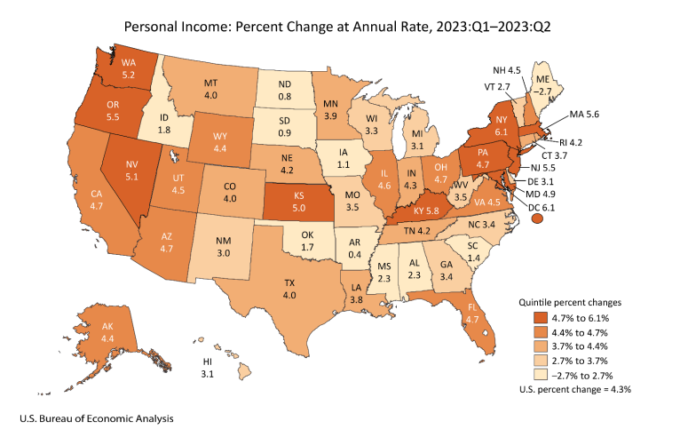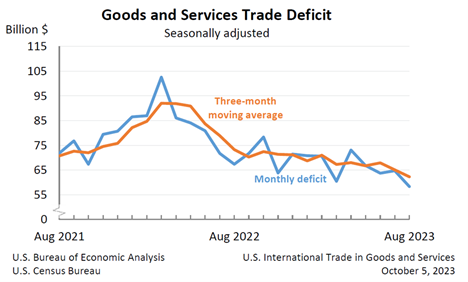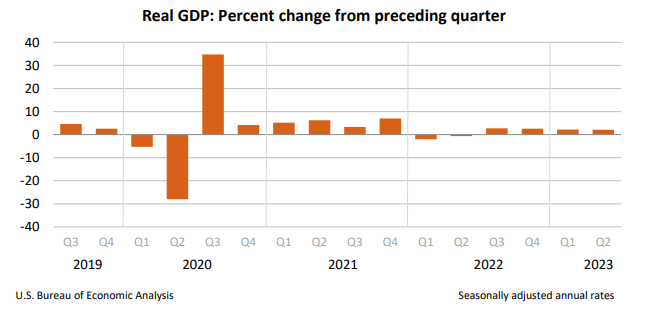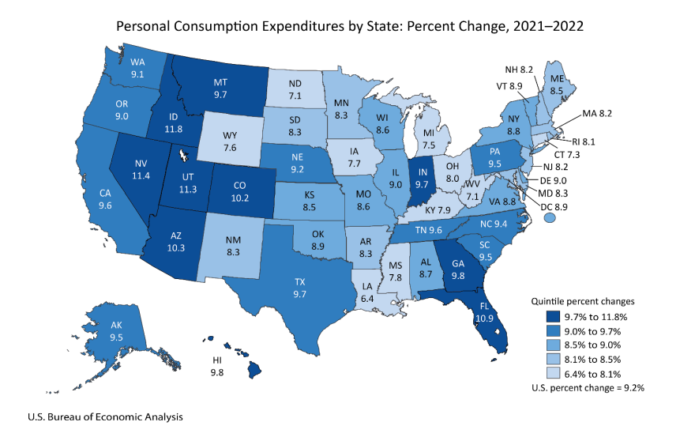Delaney O’Kray-Murphy, EBRC research economist
Valorie Rice, senior business information specialist
Alexandra Jaeger, EBRC web applications developer
Current data releases as of 06 October 2023
Arizona’s personal income increased at an annual rate of 4.7% in the second quarter, ranking at the top of the second quintile. Personal income increased in 49 states and the District of Columbia, with New York and the District of Columbia tied for the highest growth of 6.1%. Conversely, Maine was the only state with a decrease in personal income, with a 2.7% decrease. Nationally, personal income grew by $239.7 billion in the second quarter of 2023. Earnings, property income (dividends, interest, and rent), and transfer receipts all contributed to the increase. Net earnings growth was the highest contributor to personal income growth, rising 5.3% nationally. Property income for the nation increased at a 3.7% annual rate, and transfer receipts saw a moderate 1.7% increase.
The August 2023 release of the Job Openings and Labor Turnover (JOLTS) report stated that the number of job openings in the U.S. increased to 9.6 million, while the job openings rate increased to 5.8%. The industries that saw the largest increase in job openings were professional and business services, finance and insurance, and state and local government education. Nationally, the number of hires changed little to 5.9 million, with a rate of 3.7%. Total separations in the nation were little changed at 5.7 million, with a separation rate of 3.6%. The number of quits changed little at 3.6 million and 2.3%, respectively. The number of layoffs and discharges changed little at 1.7 million and 1.1%. Other separations in the U.S. were reported at 357,000.
July home prices increased over the month for most of the metro areas tracked in the S&P CoreLogic Case-Shiller Index, including Phoenix. U.S. house prices gained 0.6% over the month and 1.0% over July of last year. On an annual basis, 12 of the 20 cities reported higher prices while eight had decreases. Phoenix house prices were among those that were lower, at -6.6%, as were most of the metro areas in the West. Las Vegas prices lowered the most at -7.2% followed by Phoenix and San Francisco at -6.2%. Chicago was again the metro area with the largest 12-month house price gains at 4.4% in July followed by Cleveland at 4.0% and New York at 3.8%.
The August goods and services trade deficit came in at $58.3 billion, down $6.4 billion from a revised $64.7 billion in July. August exports rose $4.1 billion from July to reach $256.0 billion. August imports saw a slight decline of $2.3 billion since July, reaching $314.3 billion. The decrease in the deficit reflects a decrease in the goods deficit of $5.5 billion to $84.5 billion and an increase in the services surplus of $1.0 billion to $26.2 billion. Over the year, the goods and services deficit decreased by $137.6 billion, or 20.7%. Exports increased $22.0 billion (1.1%), and imports decreased $115.6 billion (4.3%). South and Central America ($4.7), Netherlands ($3.0), and Hong Kong ($2.0) have the greatest surpluses, while China ($22.7), the European Union ($17.8) and Mexico ($12.8) have the greatest deficits (in billions).
Real gross domestic product (GDP) increased at an annual rate of 2.1% in the second quarter of 2023, according to the third estimate released by the Bureau of Economic Analysis. In the first quarter, real GDP increased 2.2%, a revised 0.2 percentage point increase from the prior estimate. The update to second quarter growth reflects a downward revision to consumer spending and imports that was offset by upward revisions to nonresidential fixed investment, exports, and inventory investment. Real gross domestic income (GDI), an alternative measure of GDP, saw a 0.2 percentage point increase to 0.7% in the second quarter. This release also provided some revised first quarter figures, showing a significant increase in quarter one GDI from -1.8% to 0.5%.
Personal consumption expenditures (PCE) in Arizona were up 10.3% in current dollars for 2022. This was more than the U.S. increase of 9.2% and placed Arizona in the top quintile among states. PCE increased in all 50 states and the District of Columbia with the percent change ranging from 6.4% in Louisiana to 11.8% in Idaho. PCE by state measures the goods and services purchased by or on behalf of households and the net expenditures of nonprofit institutions serving households by state of residence. It reflects spending by residents of a state whether or not the purchases happened within the state. Nationally, expenditures on housing and utilities, food services and accommodations, and health care were the largest contributors to the increase in consumption expenditures. Housing and utilities was the largest contributor to increases for 29 states, and in particular for Idaho, Nevada, and Utah (the states with the largest increase in PCE). Arizona was near the top in percent change for PCE but was near the middle when it comes to per capita personal consumption expenditures with $50,123 in 2022 compared to $52,542 nationally. Massachusetts was the highest out of all states at $64,214 and Mississippi was the lowest at $39,678. The District of Columbia per capita PCE was $85,732.
In August, Arizona over-the-year building permits saw a notable 7.9% increase to a total of 4,967, not seasonally adjusted. The number of single-family permits also saw a sizeable increase over the year, moving up 27.9% to 3,615. The Phoenix metropolitan area counted for a majority of the permits in the state with 3,914 issued, a 10.7% increase over the year. The number of single-family units additionally rose 26.7% to 2,415. The Tucson MSA showed similar growth, observing a 54.1% growth in the total units to 507 and a 63.9% increase in single family units to 372. Of the counties, Cochise, Coconino, Graham, Mohave, Pinal, and Yuma all saw increases in total building permits over the year, while Apache, Navajo, Santa Cruz, and Yavapai all saw declines. No changes in the number of permits issued occurred in Gila and La Paz.









